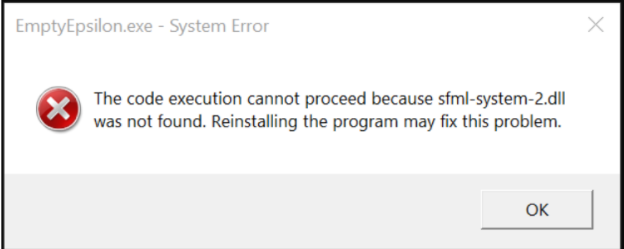
- #VISUAL STUDIO SFML SYSTEM 2.DLL WAS NOT FOUND .DLL#
- #VISUAL STUDIO SFML SYSTEM 2.DLL WAS NOT FOUND DOWNLOAD#
- #VISUAL STUDIO SFML SYSTEM 2.DLL WAS NOT FOUND WINDOWS#
The window simply contains a grid with two rows. Its name and value should be named appropriately for your project. Notice the wpfSfmlHost XML namespace parameter in the opening Window tag. The project should have been created with a MainWindow class.

Clicking the button will randomly change the color of the circle. Clicking on the RenderWindow will relocate the circle to the mouse position. The control will contain an SFML RenderWindow where we’ll display a circle. Just the containing control and a button. Protected override void OnPaintBackground( e)įor the actual window the program uses I’m going to keep it simple. Because we want an SFML RenderWindow to do the painting. We need it to extend the class so we can prevent OnPaint() and OnPaintBackground() from being called. Right-click your project in the Solution Explorer and pick “Add > New Class…”. If that makes sense…įirst we’re going to create the WinForms control that the SFML RenderWindow will use for hosting the RenderWindow. We need to have an SFML RenderWindow use a custom WinForms control, which is hosted inside a WPF control built specifically to house WinForms controls. Which is why we added the and WindowsFormsIntegration references. SFML.Net isn’t designed for use with WPF, but it can handle WinForms. In the Properties window, set the “Copy to Output Directory” value to “Copy Always”. Now right-click each of those DLL files in the Solution Explorer and pick “Properties” (you can also shift-click to select them all).

#VISUAL STUDIO SFML SYSTEM 2.DLL WAS NOT FOUND .DLL#
dll files starting with “csfml-“, drag those from the folder directly onto your project in the Solution Explorer in Visual Studio, they should show up under your project. In the “extlibs” folder of the SFML.Net library you downloaded there should be several. (sfmlnet-audio-2.dll, sfmlnet-graphics-2.dll, sfmlnet-system-2.dll, sfmlnet-window-2.dll)įinally you need to add the DLL files for the executable to use.
#VISUAL STUDIO SFML SYSTEM 2.DLL WAS NOT FOUND DOWNLOAD#
(If you don’t have them, download them from the site.) Again open the “Add Reference…” window, but this time pick the Browse tab, then click the “Browse…” button and add the DLL files from the “lib” folder of the SFML.Net package you downloaded. Next up you need to add the DLL files for SFML.Net. Just right-click the “References” item inside your project in the solution explorer and pick “Add Reference…”. Then you need to add two framework references: and WindowsFormsIntegration. Adding Referencesįirst create a new WPF Application.
#VISUAL STUDIO SFML SYSTEM 2.DLL WAS NOT FOUND WINDOWS#
I’m using Visual Studio Express 2013 for Windows Desktop as my IDE, and SFML.Net 2.2 (32-bit). But I managed to get a working setup going, which I’ll document here step-by-step. My instinct was to use SFML.Net and C#, specifically with a WPF window so I could use XAML for my layouts.Īctually getting the two to work together was harder than I expected though.

I had an idea recently for a project that I both wanted to use SFML for, and wanted lots of buttons and controls.


 0 kommentar(er)
0 kommentar(er)
